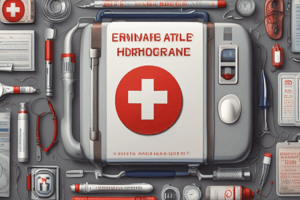Podcast
Questions and Answers
What is shock in medical terms?
What is shock in medical terms?
- A condition where the body has too much oxygen
- A type of allergic reaction that can be cured with an EpiPen
- A life-threatening medical condition that occurs when the circulatory system fails to provide enough blood flow to the body's tissues (correct)
- A heart problem that can be treated with medication
What is anaphylactic shock caused by?
What is anaphylactic shock caused by?
- Severe blood loss
- Heart problems
- Severe allergic reactions (correct)
- Dehydration
What is a common sign of shock?
What is a common sign of shock?
- Slow and strong pulse
- High blood pressure
- Warm and flushed skin
- Rapid and shallow breathing (correct)
What should you do if someone is experiencing shock?
What should you do if someone is experiencing shock?
What should you do if the person experiencing shock is bleeding?
What should you do if the person experiencing shock is bleeding?
What should you do if the person experiencing shock is unconscious?
What should you do if the person experiencing shock is unconscious?
Flashcards are hidden until you start studying
Study Notes
Shock
- Definition: A life-threatening medical condition that occurs when the circulatory system fails to provide enough blood flow to the body's tissues, leading to inadequate oxygen delivery.
Causes of Shock
- Severe blood loss (hemorrhagic shock)
- Severe allergic reactions (anaphylactic shock)
- Bacterial infections (septic shock)
- Heart problems (cardiogenic shock)
- Spinal cord injuries (neurogenic shock)
- Dehydration (hypovolemic shock)
Signs and Symptoms of Shock
- Pale or cool skin
- Fast and weak pulse
- Rapid and shallow breathing
- Nausea and vomiting
- Dizziness or fainting
- Confusion or anxiety
- Low blood pressure
First Aid for Shock
- Call 911 or seek immediate medical attention
- Lay the person down and elevate their legs 12-18 inches
- Loosen tight clothing around the neck, chest, and waist
- Keep the person calm and comfortable
- Do not give the person anything to eat or drink
- Do not try to give the person medication unless advised to do so by a medical professional
Additional First Aid Tips
- If the person is bleeding, apply direct pressure to the wound
- If the person is experiencing an allergic reaction, administer epinephrine using an EpiPen if available
- If the person is unconscious, do not move them unless they are in danger
- If the person is experiencing a seizure, clear the area around them and do not try to restrain them
Studying That Suits You
Use AI to generate personalized quizzes and flashcards to suit your learning preferences.




